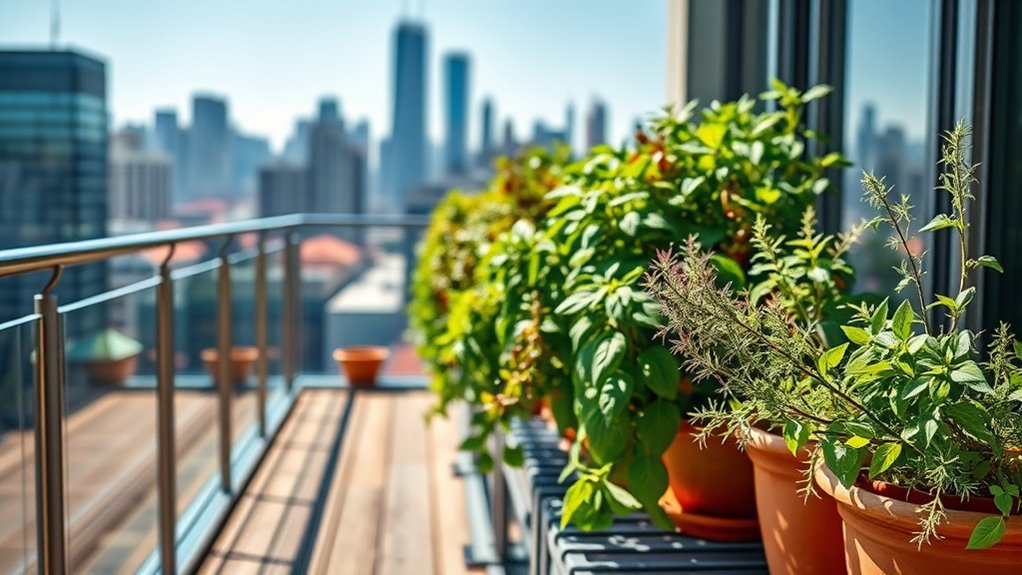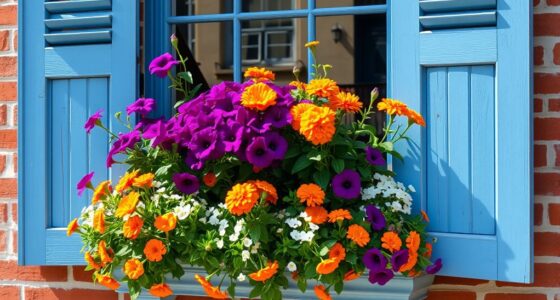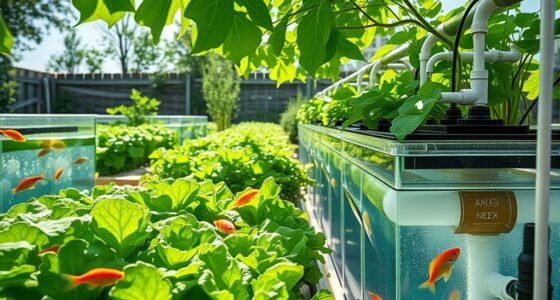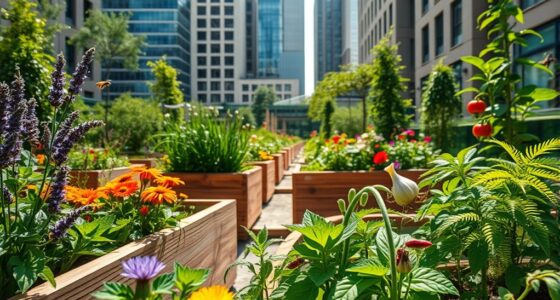Growing herbs on a balcony high above your space is easy with well-chosen containers that have drainage holes and are sized at least 8-12 inches in diameter. Place them where they’ll get six or more hours of direct sunlight daily, and use lightweight, moisture-retentive materials like plastic or ceramic. Regular watering, fertilizing, and pruning help keep your herbs healthy and lush. Keep exploring to discover more tips for creating a thriving balcony herb garden in the sky.
Key Takeaways
- Select containers with drainage holes and elevate them for better sunlight and airflow.
- Use materials like terracotta or ceramic to promote soil drying and prevent overwatering.
- Ensure herbs receive at least six hours of direct sun daily for optimal growth.
- Choose appropriately sized pots (8-12 inches) to prevent root-bound conditions and support healthy roots.
- Regularly water, fertilize, and prune herbs to maintain their health and productivity in balcony gardens.

Creating a balcony herb garden is a simple and rewarding way to bring fresh flavors and greenery into your daily life. When you start, one of the most important steps is understanding plant care. Herbs generally thrive with proper watering, sunlight, and occasional trimming. You’ll want to choose a spot on your balcony that gets plenty of sunlight—most herbs love at least six hours of direct sun each day. Keep in mind that different herbs have specific needs; for example, basil prefers warm, sunny conditions, while mint can tolerate a bit more shade. Regular watering is key, but avoid overdoing it—soil should be moist, not waterlogged. Fertilizing every few weeks with a balanced, water-soluble plant food will also help your herbs stay healthy and vigorous.
Container selection is equally essential to your success. Since you’re growing herbs on a balcony, you’ll need containers that provide adequate drainage to prevent root rot. Look for pots with drainage holes and consider using saucers underneath to catch excess water. Materials matter too—ceramic, terracotta, plastic, or metal all have their pros and cons. For instance, terracotta and ceramic pots are porous, allowing air to reach roots and helping soil dry out between waterings, which is beneficial for many herbs. Plastic pots are lightweight and retain moisture longer, making them a great choice if you want to avoid heavy lifting or if your balcony experiences wind. When selecting containers, also think about size; herbs need enough room for their roots to grow, so choose pots that are at least 8-12 inches in diameter for most herbs. Proper container selection guarantees your herbs won’t become root-bound and allows for easier maintenance.
As you set up your balcony herb garden, think about arranging your containers for easy access and optimal sunlight. Elevate some pots on stands or shelves to maximize sun exposure and create a visually appealing layout. Remember, good plant care isn’t complicated; it’s about paying attention to your herbs’ needs and adjusting your watering, fertilizing, and pruning routines accordingly. The right container selection plays a fundamental role in this process, making sure your herbs have the stability, drainage, and space they need to flourish. With just a little planning and consistency, you’ll soon enjoy a lush, aromatic garden right outside your door, providing fresh herbs for your kitchen and a touch of nature in your urban space.
Frequently Asked Questions
What Are the Best Herbs for Beginners in Balcony Gardens?
If you’re starting a balcony garden, choose herbs that are easy to grow and forgiving. Basil, mint, and chives thrive with minimal care, making them perfect for beginners. Practice herbal companion pairing by planting herbs that benefit each other, like basil with tomatoes or mint with lettuce. This companion planting improves growth and flavors, helping your balcony garden flourish. Stick to these simple herbs, and you’ll enjoy fresh herbs with less hassle.
How Do I Prevent Pests in Small Balcony Herb Gardens?
Did you know that using pest resistant herbs can reduce pest issues by up to 50%? To prevent pests in your small balcony herb garden, choose pest resistant herbs like basil and mint. You should also use natural pest control methods, such as companion planting and neem oil, to keep pests at bay. Regularly inspect your plants and keep the area clean to maintain a healthy, pest-free garden.
What Soil Mix Is Ideal for Container Herbs?
For container herbs, you want a soil mix with good drainage and nutrients. Use compost ratios like 1 part compost to 2 parts potting soil, ensuring your plants get nutrients without waterlogging. Incorporate drainage solutions such as gravel or perlite at the bottom of your container to prevent excess moisture. This mix keeps roots healthy, promotes growth, and helps avoid overwatering issues common in balcony gardens.
How Often Should I Water Balcony Herbs During Summer?
Think of your balcony herbs as dancers responding to the summer heat’s rhythm. During this fiery season, you should water them more frequently—about once a day or every other day—since the intense sun dries out the soil quickly. Keep an eye on the soil’s moisture, ensuring it stays consistently damp but not waterlogged. Adjust watering frequency based on weather and container size, so your herbs stay lively and healthy.
Can I Grow Herbs Indoors on a Balcony?
You can definitely grow herbs indoors on a balcony, especially if you want to enhance your urban gardening and balcony design. Make sure your space gets enough light, ideally south-facing, and use suitable containers with proper drainage. By doing so, you create a cozy indoor garden that boosts your balcony’s aesthetic and provides fresh herbs year-round. Just remember to water regularly and keep the environment bright for healthy growth.
Conclusion
So, next time you step onto your balcony, remember that your herbs are more than just plants—they’re your sky-high aromatherapy. From the bustling city below to the fragrant leaves above, your balcony garden bridges the gap between urban chaos and natural calm. Despite the concrete jungle, you’ve created a lush oasis that proves even in tight spaces, your herbs can reach new heights—literally and figuratively. Your balcony isn’t just a view; it’s your personal herb sanctuary.









